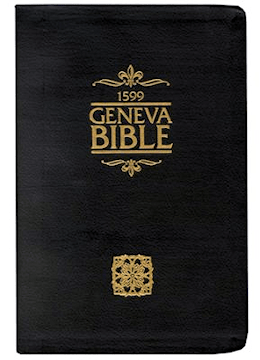Textus Receptus Bibles
Geneva Bible 1560/1599
| 8:1 | Oh that thou werest as my brother that sucked the brestes of my mother: I would finde thee without, I would kisse thee, then they should not despise thee. |
| 8:2 | I will leade thee and bring thee into my mothers house: there thou shalt teache me: and I will cause thee to drinke spiced wine, and newe wine of the pomegranate. |
| 8:3 | His left hand shalbe vnder mine head, and his right hand shall embrace me. |
| 8:4 | I charge you, O daughters of Ierusale, that you stir not vp, nor waken my loue, vntil she please. |
| 8:5 | (Who is this that commeth vp out of the wildernesse, leaning vpon her welbeloued?) I raysed thee vp vnder an apple tree: there thy mother conceiued thee: there she coceiued that bare thee. |
| 8:6 | Set mee as a seale on thine heart, and as a signet vpon thine arme: for loue is strong as death: ielousie is cruel as the graue: the coles thereof are fierie coles, and a vehement flame. |
| 8:7 | Much water can not quench loue, neither can the floods drowne it: If a man should giue all the substance of his house for loue, they would greatly contemne it. |
| 8:8 | Wee haue a litle sister, and she hath no breastes: what shall we do for our sister when she shalbe spoken for? |
| 8:9 | If shee be a wall, we will builde vpon her a siluer palace: and if she be a doore, we wil keepe her in with bordes of cedar. |
| 8:10 | I am a wall, and my breasts are as towres: then was I in his eyes as one that findeth peace. |
| 8:11 | Salomon had a vine in Baal-hamon: hee gaue the vineyarde vnto keepers: euery one bringeth for ye fruite thereof a thousand pieces of siluer. |
| 8:12 | But my vineyarde which is mine, is before me: to thee, O Salomon appertaineth a thousand pieces of siluer, and two hundreth to them that keepe the fruite thereof. |
| 8:13 | O thou that dwellest in the gardens, the companions hearken vnto thy voyce: cause me to heare it. |
| 8:14 | O my welbeloued, flee away, and be like vnto the roe, or to the yong harte vpon ye mountaines of spices. |

Geneva Bible 1560/1599
The Geneva Bible is one of the most influential and historically significant translations of the Bible into English, preceding the King James translation by 51 years. It was the primary Bible of 16th century Protestantism and was the Bible used by William Shakespeare, Oliver Cromwell, John Knox, John Donne, and John Bunyan. The language of the Geneva Bible was more forceful and vigorous and because of this, most readers strongly preferred this version at the time.
The Geneva Bible was produced by a group of English scholars who, fleeing from the reign of Queen Mary, had found refuge in Switzerland. During the reign of Queen Mary, no Bibles were printed in England, the English Bible was no longer used in churches and English Bibles already in churches were removed and burned. Mary was determined to return Britain to Roman Catholicism.
The first English Protestant to die during Mary's turbulent reign was John Rogers in 1555, who had been the editor of the Matthews Bible. At this time, hundreds of Protestants left England and headed for Geneva, a city which under the leadership of Calvin, had become the intellectual and spiritual capital of European Protestants.
One of these exiles was William Whittingham, a fellow of Christ Church at Oxford University, who had been a diplomat, a courtier, was much traveled and skilled in many languages including Greek and Hebrew. He eventually succeeded John Knox as the minister of the English congregation in Geneva. Whittingham went on to publish the 1560 Geneva Bible.
This version is significant because, it came with a variety of scriptural study guides and aids, which included verse citations that allow the reader to cross-reference one verse with numerous relevant verses in the rest of the Bible, introductions to each book of the Bible that acted to summarize all of the material that each book would cover, maps, tables, woodcut illustrations, indices, as well as other included features, all of which would eventually lead to the reputation of the Geneva Bible as history's very first study Bible.